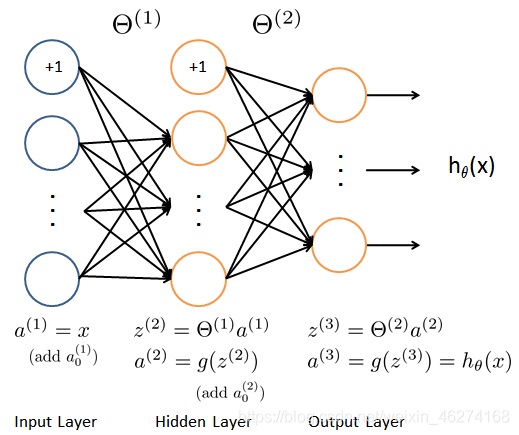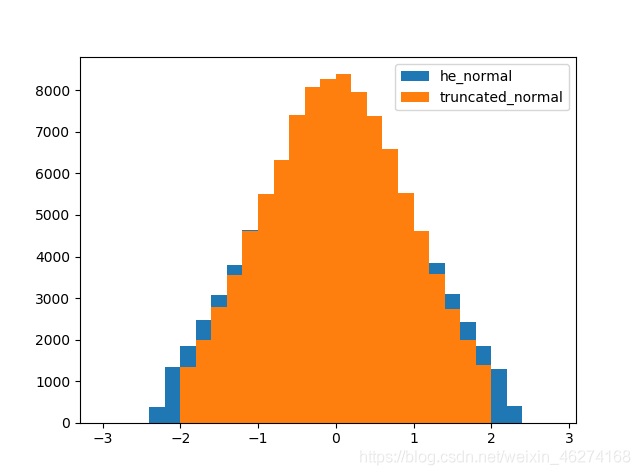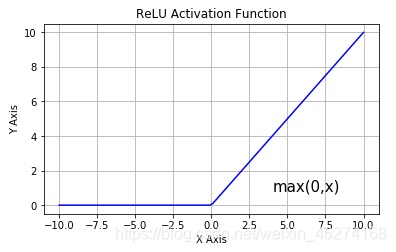详解TensorFlow2实现前向传播
目录
- 概述
- 会用到的函数
- 张量最小值
- 张量最大值
- 数据集分批
- 迭代
- 截断正态分布
- relu 激活函数
- one_hot
- assign_sub
- 准备工作
- train 函数
- run 函数
- 完整代码
概述
前向传播 (Forward propagation) 是将上一层输出作为下一层的输入, 并计算下一层的输出, 一直到运算到输出层为止.

会用到的函数

张量最小值
```reduce_min``函数可以帮助我们计算一个张量各个维度上元素的最小值.
格式:
tf.math.reduce_min(
input_tensor, axis=None, keepdims=False, name=None
)
参数:
- input_tensor: 传入的张量
- axis: 维度, 默认计算所有维度
- keepdims: 如果为真保留维度, 默认为 False
- name: 数据名称
张量最大值
```reduce_max``函数可以帮助我们计算一个张量各个维度上元素的最大值.
格式:
tf.math.reduce_max(
input_tensor, axis=None, keepdims=False, name=None
)
参数:
- input_tensor: 传入的张量
- axis: 维度, 默认计算所有维度
- keepdims: 如果为真保留维度, 默认为 False
- name: 数据名称
数据集分批
from_tensor_slices可以帮助我们切分传入 Tensor 的第一个维度. 得到的每个切片都是一个样本数据.

格式:
@staticmethod
from_tensor_slices(
tensors
)
迭代
我们可以调用iter函数来生成迭代器.
格式:
iter(object[, sentinel])
参数:
-object: 支持迭代的集合对象
- sentinel: 如果传递了第二个参数, 则参数 object 必须是一个可调用的对象 (如, 函数). 此时, iter 创建了一个迭代器对象, 每次调用这个迭代器对象的
__next__()方法时, 都会调用 object
例子:
list = [1, 2, 3] i = iter(list) print(next(i)) print(next(i)) print(next(i))
输出结果:
1
2
3
截断正态分布
truncated_normal可以帮助我们生成一个截断的正态分布. 生成的正态分布值会在两倍的标准差的范围之内.

格式:
tf.random.truncated_normal(
shape, mean=0.0, stddev=1.0, dtype=tf.dtypes.float32, seed=None, name=None
)
参数:
- shape: 张量的形状
- mean: 正态分布的均值, 默认 0.0
- stddev: 正态分布的标准差, 默认为 1.0
- dtype: 数据类型, 默认为 float32
- seed: 随机数种子
- name: 数据名称
relu 激活函数
激活函数有 sigmoid, maxout, relu 等等函数. 通过激活函数我们可以使得各个层之间达成非线性关系.

激活函数可以帮助我们提高模型健壮性, 提高非线性表达能力, 缓解梯度消失问题.
one_hot
tf.one_hot函数是讲 input 准换为 one_hot 类型数据输出. 相当于将多个数值联合放在一起作为多个相同类型的向量.
格式:
tf.one_hot(
indices, depth, on_value=None, off_value=None, axis=None, dtype=None, name=None
)
参数:
- indices: 索引的张量
- depth: 指定独热编码维度的标量
- on_value: 索引 indices[j] = i 位置处填充的标量,默认为 1
- off_value: 索引 indices[j] != i 所有位置处填充的标量, 默认为 0
- axis: 填充的轴, 默认为 -1 (最里面的新轴)
- dtype: 输出张量的数据格式
- name:数据名称
assign_sub
assign_sub可以帮助我们实现张量自减.
格式:
tf.compat.v1.assign_sub(
ref, value, use_locking=None, name=None
)
参数:
- ref: 多重张量
- value: 张量
- use_locking: 锁
- name: 数据名称
准备工作

import tensorflow as tf # 定义超参数 batch_size = 256 # 一次训练的样本数目 learning_rate = 0.001 # 学习率 iteration_num = 20 # 迭代次数 # 读取mnist数据集 (x, y), _ = tf.keras.datasets.mnist.load_data() # 读取训练集的特征值和目标值 print(x[:5]) # 调试输出前5个图 print(y[:5]) # 调试输出前5个目标值数字 print(x.shape) # (60000, 28, 28) 单通道 print(y.shape) # (60000,) # 转换成常量tensor x = tf.convert_to_tensor(x, dtype=tf.float32) / 255 # 转换为0~1的形式 y = tf.convert_to_tensor(y, dtype=tf.int32) # 转换为整数形式 # 调试输出范围 print(tf.reduce_min(x), tf.reduce_max(x)) # 0~1 print(tf.reduce_min(y), tf.reduce_max(y)) # 0~9 # 分割数据集 train_db = tf.data.Dataset.from_tensor_slices((x, y)).batch(batch_size) # 256为一个batch train_iter = iter(train_db) # 生成迭代对象 # 定义权重和bias [256, 784] => [256, 256] => [256, 128] => [128, 10] w1 = tf.Variable(tf.random.truncated_normal([784, 256], stddev=0.1)) # 标准差为0.1的截断正态分布 b1 = tf.Variable(tf.zeros([256])) # 初始化为0 w2 = tf.Variable(tf.random.truncated_normal([256, 128], stddev=0.1)) # 标准差为0.1的截断正态分布 b2 = tf.Variable(tf.zeros([128])) # 初始化为0 w3 = tf.Variable(tf.random.truncated_normal([128, 10], stddev=0.1)) # 标准差为0.1的截断正态分布 b3 = tf.Variable(tf.zeros([10])) # 初始化为0
输出结果:
[[[0 0 0 ... 0 0 0]
[0 0 0 ... 0 0 0]
[0 0 0 ... 0 0 0]
...
[0 0 0 ... 0 0 0]
[0 0 0 ... 0 0 0]
[0 0 0 ... 0 0 0]][[0 0 0 ... 0 0 0]
[0 0 0 ... 0 0 0]
[0 0 0 ... 0 0 0]
...
[0 0 0 ... 0 0 0]
[0 0 0 ... 0 0 0]
[0 0 0 ... 0 0 0]][[0 0 0 ... 0 0 0]
[0 0 0 ... 0 0 0]
[0 0 0 ... 0 0 0]
...
[0 0 0 ... 0 0 0]
[0 0 0 ... 0 0 0]
[0 0 0 ... 0 0 0]][[0 0 0 ... 0 0 0]
[0 0 0 ... 0 0 0]
[0 0 0 ... 0 0 0]
...
[0 0 0 ... 0 0 0]
[0 0 0 ... 0 0 0]
[0 0 0 ... 0 0 0]][[0 0 0 ... 0 0 0]
[0 0 0 ... 0 0 0]
[0 0 0 ... 0 0 0]
...
[0 0 0 ... 0 0 0]
[0 0 0 ... 0 0 0]
[0 0 0 ... 0 0 0]]]
[5 0 4 1 9]
(60000, 28, 28)
(60000,)
tf.Tensor(0.0, shape=(), dtype=float32) tf.Tensor(1.0, shape=(), dtype=float32)
tf.Tensor(0, shape=(), dtype=int32) tf.Tensor(9, shape=(), dtype=int32)
train 函数
def train(epoch): # 训练
for step, (x, y) in enumerate(train_db): # 每一批样本遍历
# 把x平铺 [256, 28, 28] => [256, 784]
x = tf.reshape(x, [-1, 784])
with tf.GradientTape() as tape: # 自动求解
# 第一个隐层 [256, 784] => [256, 256]
# [256, 784]@[784, 256] + [256] => [256, 256] + [256] => [256, 256] + [256, 256] (广播机制)
h1 = x @ w1 + tf.broadcast_to(b1, [x.shape[0], 256])
h1 = tf.nn.relu(h1) # relu激活
# 第二个隐层 [256, 256] => [256, 128]
h2 = h1 @ w2 + b2
h2 = tf.nn.relu(h2) # relu激活
# 输出层 [256, 128] => [128, 10]
out = h2 @ w3 + b3
# 计算损失MSE(Mean Square Error)
y_onehot = tf.one_hot(y, depth=10) # 转换成one_hot编码
loss = tf.square(y_onehot - out) # 计算总误差
loss = tf.reduce_mean(loss) # 计算平均误差MSE
# 计算梯度
grads = tape.gradient(loss, [w1, b1, w2, b2, w3, b3])
# 更新权重
w1.assign_sub(learning_rate * grads[0]) # 自减梯度*学习率
b1.assign_sub(learning_rate * grads[1]) # 自减梯度*学习率
w2.assign_sub(learning_rate * grads[2]) # 自减梯度*学习率
b2.assign_sub(learning_rate * grads[3]) # 自减梯度*学习率
w3.assign_sub(learning_rate * grads[4]) # 自减梯度*学习率
b3.assign_sub(learning_rate * grads[5]) # 自减梯度*学习率
if step % 100 == 0: # 每运行100个批次, 输出一次
print("epoch:", epoch, "step:", step, "loss:", float(loss))
run 函数
def run():
for i in range(iteration_num): # 迭代20次
train(i)
完整代码
import tensorflow as tf
# 定义超参数
batch_size = 256 # 一次训练的样本数目
learning_rate = 0.001 # 学习率
iteration_num = 20 # 迭代次数
# 读取mnist数据集
(x, y), _ = tf.keras.datasets.mnist.load_data() # 读取训练集的特征值和目标值
print(x[:5]) # 调试输出前5个图
print(y[:5]) # 调试输出前5个目标值数字
print(x.shape) # (60000, 28, 28) 单通道
print(y.shape) # (60000,)
# 转换成常量tensor
x = tf.convert_to_tensor(x, dtype=tf.float32) / 255 # 转换为0~1的形式
y = tf.convert_to_tensor(y, dtype=tf.int32) # 转换为整数形式
# 调试输出范围
print(tf.reduce_min(x), tf.reduce_max(x)) # 0~1
print(tf.reduce_min(y), tf.reduce_max(y)) # 0~9
# 分割数据集
train_db = tf.data.Dataset.from_tensor_slices((x, y)).batch(batch_size) # 256为一个batch
train_iter = iter(train_db) # 生成迭代对象
# 定义权重和bias [256, 784] => [256, 256] => [256, 128] => [128, 10]
w1 = tf.Variable(tf.random.truncated_normal([784, 256], stddev=0.1)) # 标准差为0.1的截断正态分布
b1 = tf.Variable(tf.zeros([256])) # 初始化为0
w2 = tf.Variable(tf.random.truncated_normal([256, 128], stddev=0.1)) # 标准差为0.1的截断正态分布
b2 = tf.Variable(tf.zeros([128])) # 初始化为0
w3 = tf.Variable(tf.random.truncated_normal([128, 10], stddev=0.1)) # 标准差为0.1的截断正态分布
b3 = tf.Variable(tf.zeros([10])) # 初始化为0
def train(epoch): # 训练
for step, (x, y) in enumerate(train_db): # 每一批样本遍历
# 把x平铺 [256, 28, 28] => [256, 784]
x = tf.reshape(x, [-1, 784])
with tf.GradientTape() as tape: # 自动求解
# 第一个隐层 [256, 784] => [256, 256]
# [256, 784]@[784, 256] + [256] => [256, 256] + [256] => [256, 256] + [256, 256] (广播机制)
h1 = x @ w1 + tf.broadcast_to(b1, [x.shape[0], 256])
h1 = tf.nn.relu(h1) # relu激活
# 第二个隐层 [256, 256] => [256, 128]
h2 = h1 @ w2 + b2
h2 = tf.nn.relu(h2) # relu激活
# 输出层 [256, 128] => [128, 10]
out = h2 @ w3 + b3
# 计算损失MSE(Mean Square Error)
y_onehot = tf.one_hot(y, depth=10) # 转换成one_hot编码
loss = tf.square(y_onehot - out) # 计算总误差
loss = tf.reduce_mean(loss) # 计算平均误差MSE
# 计算梯度
grads = tape.gradient(loss, [w1, b1, w2, b2, w3, b3])
# 更新权重
w1.assign_sub(learning_rate * grads[0]) # 自减梯度*学习率
b1.assign_sub(learning_rate * grads[1]) # 自减梯度*学习率
w2.assign_sub(learning_rate * grads[2]) # 自减梯度*学习率
b2.assign_sub(learning_rate * grads[3]) # 自减梯度*学习率
w3.assign_sub(learning_rate * grads[4]) # 自减梯度*学习率
b3.assign_sub(learning_rate * grads[5]) # 自减梯度*学习率
if step % 100 == 0: # 每运行100个批次, 输出一次
print("epoch:", epoch, "step:", step, "loss:", float(loss))
def run():
for i in range(iteration_num): # 迭代20次
train(i)
if __name__ == "__main__":
run()
输出结果:
epoch: 0 step: 0 loss: 0.5439826250076294
epoch: 0 step: 100 loss: 0.2263326346874237
epoch: 0 step: 200 loss: 0.19458135962486267
epoch: 1 step: 0 loss: 0.1788959801197052
epoch: 1 step: 100 loss: 0.15782299637794495
epoch: 1 step: 200 loss: 0.1580992043018341
epoch: 2 step: 0 loss: 0.15085121989250183
epoch: 2 step: 100 loss: 0.1432340145111084
epoch: 2 step: 200 loss: 0.14373672008514404
epoch: 3 step: 0 loss: 0.13810500502586365
epoch: 3 step: 100 loss: 0.13337770104408264
epoch: 3 step: 200 loss: 0.1334681361913681
epoch: 4 step: 0 loss: 0.12887853384017944
epoch: 4 step: 100 loss: 0.12551936507225037
epoch: 4 step: 200 loss: 0.125375896692276
epoch: 5 step: 0 loss: 0.12160968780517578
epoch: 5 step: 100 loss: 0.1190723180770874
epoch: 5 step: 200 loss: 0.11880680173635483
epoch: 6 step: 0 loss: 0.11563797295093536
epoch: 6 step: 100 loss: 0.11367204040288925
epoch: 6 step: 200 loss: 0.11331651359796524
epoch: 7 step: 0 loss: 0.11063456535339355
epoch: 7 step: 100 loss: 0.10906648635864258
epoch: 7 step: 200 loss: 0.10866570472717285
epoch: 8 step: 0 loss: 0.10636782646179199
epoch: 8 step: 100 loss: 0.10510052740573883
epoch: 8 step: 200 loss: 0.10468046367168427
epoch: 9 step: 0 loss: 0.10268573462963104
epoch: 9 step: 100 loss: 0.10163718461990356
epoch: 9 step: 200 loss: 0.10121693462133408
epoch: 10 step: 0 loss: 0.09949333965778351
epoch: 10 step: 100 loss: 0.09859145432710648
epoch: 10 step: 200 loss: 0.09819269925355911
epoch: 11 step: 0 loss: 0.0966767817735672
epoch: 11 step: 100 loss: 0.09586615860462189
epoch: 11 step: 200 loss: 0.09550992399454117
epoch: 12 step: 0 loss: 0.09417577087879181
epoch: 12 step: 100 loss: 0.09341947734355927
epoch: 12 step: 200 loss: 0.09310202300548553
epoch: 13 step: 0 loss: 0.09193204343318939
epoch: 13 step: 100 loss: 0.09122277796268463
epoch: 13 step: 200 loss: 0.09092779457569122
epoch: 14 step: 0 loss: 0.0899026170372963
epoch: 14 step: 100 loss: 0.08923697471618652
epoch: 14 step: 200 loss: 0.08895798027515411
epoch: 15 step: 0 loss: 0.08804921805858612
epoch: 15 step: 100 loss: 0.08742769062519073
epoch: 15 step: 200 loss: 0.0871589332818985
epoch: 16 step: 0 loss: 0.08635203540325165
epoch: 16 step: 100 loss: 0.0857706069946289
epoch: 16 step: 200 loss: 0.0855005756020546
epoch: 17 step: 0 loss: 0.08479145169258118
epoch: 17 step: 100 loss: 0.08423925191164017
epoch: 17 step: 200 loss: 0.08396687358617783
epoch: 18 step: 0 loss: 0.08334997296333313
epoch: 18 step: 100 loss: 0.08281457424163818
epoch: 18 step: 200 loss: 0.08254452794790268
epoch: 19 step: 0 loss: 0.08201286941766739
epoch: 19 step: 100 loss: 0.08149122446775436
epoch: 19 step: 200 loss: 0.08122102916240692
到此这篇关于详解TensorFlow2实现前向传播的文章就介绍到这了,更多相关TensorFlow2前向传播内容请搜索hwidc以前的文章或继续浏览下面的相关文章希望大家以后多多支持hwidc!
【文章出处:国外服务器 转发请说明出处】